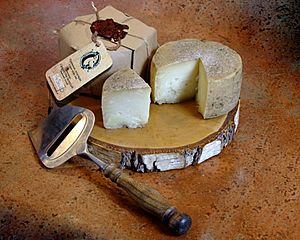Farmstead cheese facts for kids
Farmstead cheese is a special type of cheese. It's made right on the farm where the milk comes from. This means the cheese makers use milk only from their own animals. They don't buy milk from other farms. This makes farmstead cheeses very unique. Their taste often depends on the farm's local environment. This includes the soil, plants, and climate. This special taste is sometimes called "terroir." Most farmstead cheese comes from cows, goats, or sheep. Some is even made from water buffalo milk, like Buffalo mozzarella.
Contents
What Makes Farmstead Cheese Special?
Farmstead cheeses are usually made on family farms. They are often made in small amounts. You can often find them at local farmers' markets. In Europe, these cheeses are often called "farmhouse cheeses." They have been made there for a very long time. In North America, making farmstead cheese has become popular again in recent years.
Where is Farmstead Cheese Popular?
In the United States, some top states for farmstead cheese are Vermont, California, and Wisconsin. But it's also growing fast in other states, like Georgia. North Carolina has also become known for its farmstead cheeses. They even have a special WNC Cheese Trail.
Why is Farmstead Cheese Unique?
Because these cheeses are made on a small scale, they can offer special qualities. For example, some cheese comes from cows fed only non-GMO foods. This means their feed has not been changed in a lab. This makes each farmstead cheese truly one-of-a-kind!
External Sites


